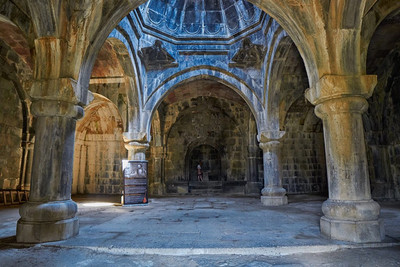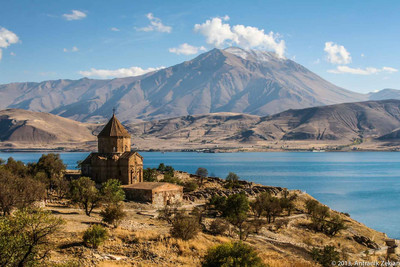15 facts about Armenia
Welcome to Armenia, a small country with a thousand-year history.
![]() Armenia is the smallest by area of all the republics of the former USSR. Its area is 2 times smaller than the territory of Georgia, 20 times smaller than Ukraine, 100 times smaller than Kazakhstan and 570 times smaller than Russia.
Armenia is the smallest by area of all the republics of the former USSR. Its area is 2 times smaller than the territory of Georgia, 20 times smaller than Ukraine, 100 times smaller than Kazakhstan and 570 times smaller than Russia.
![]() Armenia is the oldest state among the states of the former USSR, which in the I century BC was one of the three largest states in the world and at the beginning of the IV century adopted Christianity as the state religion, even earlier than the Roman Empire.
Armenia is the oldest state among the states of the former USSR, which in the I century BC was one of the three largest states in the world and at the beginning of the IV century adopted Christianity as the state religion, even earlier than the Roman Empire.
![]() Armenia is one of the most densely populated countries. The population density in Armenia is 2 times higher than in Georgia, the North Caucasus, Ukraine and Belarus, 15 times higher than in Russia and Kazakhstan, 3-4 times higher than in the Baltic countries.
Armenia is one of the most densely populated countries. The population density in Armenia is 2 times higher than in Georgia, the North Caucasus, Ukraine and Belarus, 15 times higher than in Russia and Kazakhstan, 3-4 times higher than in the Baltic countries.
![]() Only 20% of Armenians live in Armenia. The Armenian Diaspora is 10-12 million people, while the population of Armenia itself is about 3 million inhabitants. The majority of Armenians are in the USA, Russia, Iran, Lebanon, Ukraine, France, Syria and Argentina.
Only 20% of Armenians live in Armenia. The Armenian Diaspora is 10-12 million people, while the population of Armenia itself is about 3 million inhabitants. The majority of Armenians are in the USA, Russia, Iran, Lebanon, Ukraine, France, Syria and Argentina.
![]() Armenia is the only country in the Middle East that has no access to the sea.
Armenia is the only country in the Middle East that has no access to the sea.
![]() The state religion of Armenia is the Armenian Apostolic Church. It is an independent denomination that is not part of any of the currents of Christianity, but at the same time is the oldest of them. It is interesting that Armenia was the first country where Christianity received the status of a state religion. It was in Armenia that the first church was built — a real treasure for pilgrims.
The state religion of Armenia is the Armenian Apostolic Church. It is an independent denomination that is not part of any of the currents of Christianity, but at the same time is the oldest of them. It is interesting that Armenia was the first country where Christianity received the status of a state religion. It was in Armenia that the first church was built — a real treasure for pilgrims.
![]() There are different variants of the Armenian language: Grabar (the language of worship), Western Armenian (it was spoken by the inhabitants of Western Armenia and is now spoken by the foreign Diaspora), Eastern Armenian (the official language of the Republic of Armenia), Artsakh language (the unwritten language of the Artsakh people), Hamshen language (the unwritten language of the Hemshils and Amshens) and more more than 60 dialects. These languages differ so much from each other that, for example, an Hamshenets and a resident of Artsakh are unlikely to understand each other without an interpreter.
There are different variants of the Armenian language: Grabar (the language of worship), Western Armenian (it was spoken by the inhabitants of Western Armenia and is now spoken by the foreign Diaspora), Eastern Armenian (the official language of the Republic of Armenia), Artsakh language (the unwritten language of the Artsakh people), Hamshen language (the unwritten language of the Hemshils and Amshens) and more more than 60 dialects. These languages differ so much from each other that, for example, an Hamshenets and a resident of Artsakh are unlikely to understand each other without an interpreter.
![]() Apricot is also a symbol of Armenia. It is believed that it was the Armenian gardeners who brought out the apricot in immemorial times before our era. It has been established for certain that Armenians have been growing apricots for at least three thousand years. Apricot pits dating back to the 1st millennium BC were found by archaeologists at the pagan temple in Garni.
Apricot is also a symbol of Armenia. It is believed that it was the Armenian gardeners who brought out the apricot in immemorial times before our era. It has been established for certain that Armenians have been growing apricots for at least three thousand years. Apricot pits dating back to the 1st millennium BC were found by archaeologists at the pagan temple in Garni.
![]() Special grape varieties grow in Armenia, thanks to which high-quality wine is produced here. It is worth noting that even the French recognize this fact. Armenia boasts the oldest winery in the world. It was discovered a few years ago in the village of Areni. Now it is not functioning, but archaeologists have found what is left of it. According to experts, wine was produced here more than six thousand years ago.
Special grape varieties grow in Armenia, thanks to which high-quality wine is produced here. It is worth noting that even the French recognize this fact. Armenia boasts the oldest winery in the world. It was discovered a few years ago in the village of Areni. Now it is not functioning, but archaeologists have found what is left of it. According to experts, wine was produced here more than six thousand years ago.
![]() The Armenian language group is not included in any of the existing Indo-European language groups, and its closest relatives are the extinct Anatolian group (it was spoken by the Hittites) and the now existing Iranian group (it is spoken by Persians, Talysh, Tats, Kurds, Ossetians, etc.), while being quite distantly related to them. Moreover, phonetics, morphology, grammar and at least 1/3 of the vocabulary of the Armenian language group have nothing in common with Indo-European languages and 100% repeat similar indicators of the extinct language of ancient Cuneiform in the Hurrian language. Linguists call the Armenian alphabet one of the three most perfect in the world (along with Georgian and Korean).
The Armenian language group is not included in any of the existing Indo-European language groups, and its closest relatives are the extinct Anatolian group (it was spoken by the Hittites) and the now existing Iranian group (it is spoken by Persians, Talysh, Tats, Kurds, Ossetians, etc.), while being quite distantly related to them. Moreover, phonetics, morphology, grammar and at least 1/3 of the vocabulary of the Armenian language group have nothing in common with Indo-European languages and 100% repeat similar indicators of the extinct language of ancient Cuneiform in the Hurrian language. Linguists call the Armenian alphabet one of the three most perfect in the world (along with Georgian and Korean).
![]() Anthropological Almost all Armenians belong to the Armenoid race. It is also called the Near-Asian, Assyroid or Hittite race. Besides Armenians, this race also includes Assyrians, Eastern Georgians, Jews, some Chechen Teips, most of the Syrians and Lebanese, most of the modern Turks (mainly living in eastern Turkey), Kurds and a number of extinct peoples - Hittites, Akkadians, Babylonians, Sumerians, Medes. The Near-Asian (Armenoid) race is considered a hybrid of the Alpine and Mediterranean races in a ratio of 2 to 1. The closest relatives of the Armenoid race are the Pontic, Caucasian, Caspian and Dinaric races. In terms of skin color, the Armenoid race is darker than the Caucasian race, but lighter than the Caspian race and the Iranian, being, as it were, between them.
Anthropological Almost all Armenians belong to the Armenoid race. It is also called the Near-Asian, Assyroid or Hittite race. Besides Armenians, this race also includes Assyrians, Eastern Georgians, Jews, some Chechen Teips, most of the Syrians and Lebanese, most of the modern Turks (mainly living in eastern Turkey), Kurds and a number of extinct peoples - Hittites, Akkadians, Babylonians, Sumerians, Medes. The Near-Asian (Armenoid) race is considered a hybrid of the Alpine and Mediterranean races in a ratio of 2 to 1. The closest relatives of the Armenoid race are the Pontic, Caucasian, Caspian and Dinaric races. In terms of skin color, the Armenoid race is darker than the Caucasian race, but lighter than the Caspian race and the Iranian, being, as it were, between them.
![]() Among the peoples of the Middle East, Armenians are among the three nations with the highest level of higher education. The three also include Georgians and Jews.
Among the peoples of the Middle East, Armenians are among the three nations with the highest level of higher education. The three also include Georgians and Jews.
![]() Almost all Armenians, except for the Armenian language, consider at least one other language as their native language: 30% - Russian, 20% - English, 10% - French, 8% - Spanish, 8% - Arabic, etc.
Almost all Armenians, except for the Armenian language, consider at least one other language as their native language: 30% - Russian, 20% - English, 10% - French, 8% - Spanish, 8% - Arabic, etc.
![]() The Republic of Armenia occupies only 1/12 (8%) of the territory of the Armenian Highlands. The remaining 92% is divided between Turkey (300 thousand km2), Iran (40 thousand km2), the Nagorno-Karabakh Republic (11 thousand km2), Azerbaijan (15 thousand km2) and Georgia (7 thousand km2).
The Republic of Armenia occupies only 1/12 (8%) of the territory of the Armenian Highlands. The remaining 92% is divided between Turkey (300 thousand km2), Iran (40 thousand km2), the Nagorno-Karabakh Republic (11 thousand km2), Azerbaijan (15 thousand km2) and Georgia (7 thousand km2).










